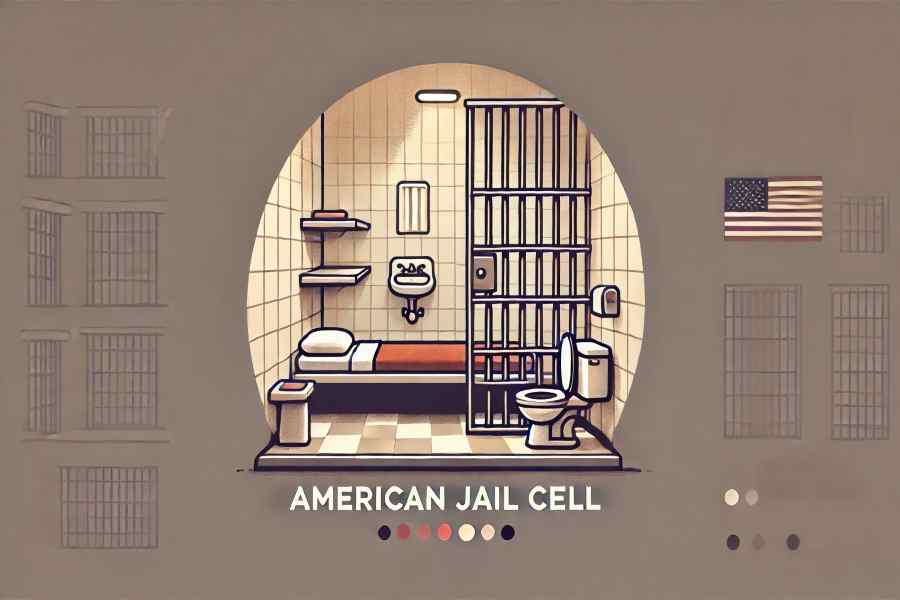
Jail cells are a fundamental part of the criminal justice system in America. Understanding what a jail cell looks like in America helps to shed light on the daily realities inmates face. Depending on the facility, these cells vary in size, design, and features, but certain characteristics are commonly found across the country. This article delves into the specifics of American jail cells, offering a detailed description and analysis to give readers a comprehensive understanding of these spaces.
What Does a Jail Cell Look Like in America?
A typical jail cell in America is usually small, measuring around 6 by 8 feet. It contains basic amenities such as a bed, toilet, and sink, often made of stainless steel for durability. The walls are typically concrete, and the door is a heavy steel gate with small windows. The environment is stark, designed for security and minimal comfort.
What is the Layout of a Typical Jail Cell in America?
A typical jail cell in America is designed to be functional yet minimalistic. These cells are usually around 6 by 8 feet in size and constructed from durable materials such as concrete and steel. The bed is often a metal frame bolted to the floor, with a thin mattress for basic comfort. Next to the bed, there is usually a combination toilet and sink unit made of stainless steel to prevent tampering and damage.
The walls of a jail cell are often painted in neutral colors like gray or beige, creating a stark and uninviting atmosphere. The door to the cell is a solid metal gate, often with a small window to allow guards to check on inmates without opening the door. Ventilation is provided through small grilles, ensuring airflow but maintaining security.
Lighting in these cells is typically provided by fluorescent fixtures embedded in the ceiling. This type of lighting is harsh and constant, contributing to the overall austere environment. Privacy is minimal, with inmates always visible to guards through the door’s window or bars.
The layout of these cells is designed for practicality and security, ensuring that inmates are confined yet monitored. This design prioritizes the safety of both the inmates and the correctional officers, making any attempts at escape or self-harm more difficult.
How Do Jail Cells Differ Across Various Types of Facilities?
County Jails vs. State Prisons: County jails are generally designed for short-term incarceration, with smaller, more crowded cells than state prisons. State prisons, in contrast, are meant for long-term sentences, often featuring slightly larger cells and more personal space for inmates.
Federal Prisons: Federal prisons tend to have more standardized cells, adhering to federal regulations. These cells might include additional security features and more robust construction materials.
Juvenile Detention Centers: Cells in juvenile detention centers are designed with the youth in mind. They are often smaller and more secure, with additional safety features to protect younger inmates from harming themselves or others.
Maximum vs. Minimum Security: Maximum security cells are highly restrictive, with reinforced doors and limited inmate movement. Minimum security facilities, however, have more relaxed environments, with less restrictive cell designs and more communal living spaces.
Special Housing Units (SHU): These units are for inmates requiring isolation, either for their protection or due to their behavior. SHU cells are more confined and isolated from the general population, with stricter inmate movement and interaction controls.
When Were Modern Jail Cells First Introduced in America?
- Modern jail cells as we know them began to take shape in the early 20th century. Before this time, jail cells were often overcrowded, unsanitary, and poorly constructed. The rise of the Progressive Era brought significant reforms to the criminal justice system, including improvements in the design and management of jails and prisons.
- During this period, the focus shifted towards creating more standardized and humane inmate conditions. Introducing regulations and oversight led to the construction more secure and hygienic facilities. The materials used in building cells also evolved, shifting towards concrete and steel for durability and security.
- The design of modern jail cells continued to evolve through the latter half of the 20th century, influenced by ongoing reforms and advances in architecture and materials science. Today, the design of jail cells reflects a balance between security, cost efficiency, and the need to provide a safe environment for inmates and staff.
Exploring the Psychological Impact of Jail Cell Environments
Impact on Mental Health
The stark, confined environment of a jail cell can have significant psychological effects on inmates. The lack of natural light, minimal social interaction, and constant surveillance contribute to feelings of isolation and anxiety.
Behavioral Consequences
Extended time in a jail cell can lead to changes in behavior. Inmates may become withdrawn, depressed, or exhibit increased aggression. The environment is designed to control behavior, but it can also exacerbate mental health issues.
Rehabilitation Challenges
The harsh environment can hinder rehabilitation efforts. Inmates often struggle to engage in educational or vocational programs when confined to a small, unstimulating space for most of the day.
Coping Mechanisms
Inmates develop various coping mechanisms to deal with the stress of being confined. Some engage in physical exercise, reading, or other activities to pass the time and maintain their mental health.
Policy Implications
Understanding the psychological impact of jail cell environments is crucial for policymakers. There is a growing recognition of the need to improve these conditions to support the mental health and rehabilitation of inmates.
Conclusion
Understanding what a jail cell looks like in America provides insight into inmates’ daily lives and the conditions they endure. These cells are designed with security, cost efficiency, and minimal comfort in mind, reflecting broader societal attitudes toward incarceration. While the primary goal is to ensure safety and control, the psychological impact on inmates is significant and warrants ongoing consideration and reform.
FAQ’s
What amenities are provided in a typical jail cell in America?
A typical jail cell in America provides minimal amenities, which usually include a metal bed frame with a thin mattress, a stainless steel combination toilet and sink unit, a small table or desk, and sometimes a shelf. These amenities are designed to meet basic needs while maintaining security and durability.
How do jail cells ensure the safety of inmates and staff?
Jail cells ensure safety through their design and construction materials. They use durable concrete and steel to prevent damage and tampering. Security features such as solid metal doors, reinforced windows, and constant surveillance help to monitor and control inmate behavior, reducing the risk of violence and escape attempts.
Can inmates personalize their jail cells?
Inmates have minimal ability to personalize their jail cells. They may have a few personal items, such as family photos or books. Still, any modifications to the cell or additional items are typically restricted to maintain security and order within the facility.








